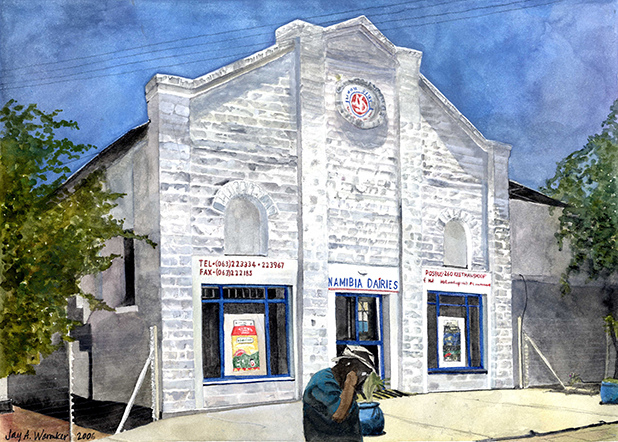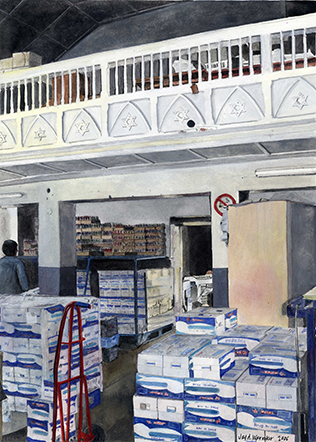 Exterior View (2005), 15” x 11” Watercolor, Jay A. Waronker
Exterior View (2005), 15” x 11” Watercolor, Jay A. Waronker
NAMIBIA
Keetmanshoop Synagogue (mid-1920s) |
|

Interior View (2005), 11” x 15” Watercolor, Jay A. Waronker
|
Jews of German and later other European origin have lived in sustainable capacity in the southwestern-most African country of Namibia for more than one and a half centuries. Once the country became a German colony in the late 1800s, the number of Jews who came to settle in Namibia increased as the growing economy provided opportunities in mining, banking, trading, real estate development, and an assortment of other businesses. Yet under this period of German rule, only about a hundred Jews ever lived in Namibia, most in Swakopmund on the central coast of the country. After Germany was defeated in World War I, Southern Africa received a mandate by the League of Nations over Namibia. At that point, the Jewish population throughout the country increased again, including the establishment of a small enclave in the southern city of Keetmanshoop. It was then that a formal congregation was established, and this led to the construction of a synagogue on a site in the city of town.
Keetmanshoop’s synagogue was looks less like a dedicated Jewish house of prayer and more like an early twentieth-century commercial building place along a sidewalk in the center of town. The two-story, unassuming building continued a local tradition in Keetmanshoop of being built out of local stone. African craftsmen trained as masons were responsible for work on the synagogue. At some point the honey-colored stone was unfortunately painted white, but otherwise the façade has changed little over the years except for some signage added and the filling in of some window openings.
During the 1950s and 1960s, the Jewish population of mostly-always-peaceful-and -stable Namibia grew, and by 1965 there were four hundred to five hundred Jews living in the country. Keetmanshoop never had more than a few dozen Jews, yet it was enough to operate a synagogue and maintain a minyan (quorum) for prayer services. Once the United Nations canceled the South African mandate over Namibia, political uncertainly led to some Jews leaving the century. By the late 1950s, the decline in Keetmanshoop’s Jewish community resulted in the synagogue closing and the selling of the building. For a quarter century, the space has been used by the Namibia Dairies as office and storage space. Once Namibia became an independent nation in 1990, even more Jews emigrated throughout the country, including at Keetmanshoop. Other than in Windhoek, the only other place in Namibia today where Jews continue to live in is Keetmanshop, although only a very few families reside there.
For decades this double-height space functioned as a synagogue for a very small yet well-organized Jewish community in Keetmanshoop, Namibia. Entrance to the synagogue was not front the street front but from the rear of the building, where there was an outdoor area for religious and social activities and celebrations and ample space for car parking. From there, one could enter the building proper via a 10’-6” x 11’-7” foyer that led to the sanctuary proper, and this anteroom also contained a stair leading up to the women’s gallery. It was here, according to Orthodox synagogue tradition, where the women sat during prayer services.
The main room of the building was the sanctuary as seen in this watercolor. From the foyer, one entered this ground floor space under the gallery level, which was supported by heavy square columns. Here the prayer service was led and the men sat. Measuring 25’-6” x 45’, at one time the room was filled with seating, a bimah (table where the Torah is read), ark, and various liturgical and architectural fittings. Yet in the 1980s, the Jews sold the synagogue to a Namibian dairy company after the community had substantially declined in numbers. This was so even though the social and political situation in Namibia remained mostly stable and positive during the independence period and beyond. With so few members left, keeping the building was no longer seemed warranted, and the expense of maintaining it too high. At the time of the sale, most of its original contents such as the furniture, lighting, ark, and bimah were removed, and today their whereabouts are unknown.
The sanctuary space, with its painted concrete floor, painted plaster walls, and tray ceiling made up of flat panels with batten strips covering the joints, has for years been used as part storage room for dairy products and part office space for the Namibian dairy company. The gallery level is also used as office space and file storage.
Painted Magen David (Star of David) patterns seen along the gallery-level railing, clearly dating to the time of the synagogue, remain in place to this day. According to the dairy manager, they were kept intact since the symbol has always been considered a sign of good luck. The dairy was doing well at the time this watercolor was painted, and the owners attributed this in part to its displayed Stars of David.
